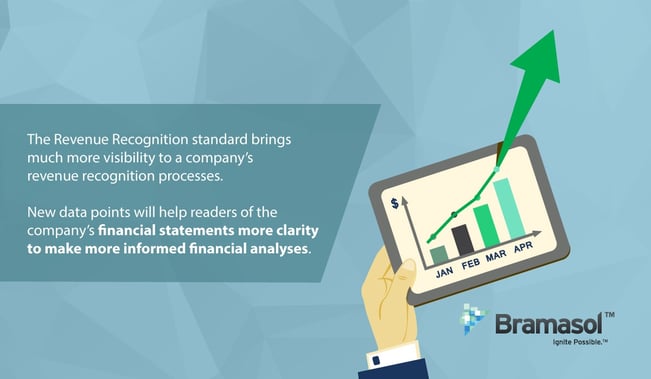 Now that the adoption deadline for ASC 606 ( IFRS 15 for IFRS filers), revenue recognition for public entities has passed, the readers of companies’ financial statements should expect a much more robust financial reporting over revenue recognition.
Now that the adoption deadline for ASC 606 ( IFRS 15 for IFRS filers), revenue recognition for public entities has passed, the readers of companies’ financial statements should expect a much more robust financial reporting over revenue recognition.
In addition to the new five step model, companies now are required to disclose in a separate footnote, a new set of data points both quantitative and qualitative about the company’s revenue recognition processes.
The objective of the new standard is to “disclose sufficient information to enable users of financial statements to understand the nature, amount, timing, and uncertainty of revenue and cash flows. Entities can accomplish this by providing qualitative and quantitative information regarding its contracts with customers, the estimates and judgments used to measure its revenue, and the nature of any assets recognized related to the costs of obtaining the contracts.”
How extended payment terms can mask important revenue recognition info in financial statements:
In a recent article published on cfo.com by Vincent Ryan on March 27, 2018, titled “Controller Charged in Revenue Recognition Scheme” he states that the SEC charged a public company controller with fraud by using a number of “improper tactics” including extended payment terms and then goes on to say that the SEC noted in its enforcement order that “The fraud created the misperception that Maxwell’s ultracapacitor growth was far more successful than reality,” Extended payment terms are very common tactics to entice potential customers into a sale because the customer will get the good or service now but will not have to pay immediately. From a company perspective, this will increase the revenue recognized but a reader of the company’s financial statements will not be able to assess the payments terms and whether there is a significant financing component embedded within the company’s revenue recognition accounting processes.
How ASC 606 new disclosure requirements can bring more transparency to financial reporting:
ASC 606 strives to change that issue by requiring significantly more disclosure regarding that missing piece of information and also will require companies to bifurcate the related interest portion from the revenue portion. It could also cause more questions from the readers of a company’s financial statements knowing that there is a significant financing component disclosure.
Disclosure of Significant Financing Components:
One of the new disclosure requirements specifically relates to the existence of a significant financing component in a revenue contract. Therefore companies will now be required to disclose to the readers of their financial statements in the new revenue disclosure any effects of financing separately from contracts with customers. The nature of the disclosure will inform the reader about whether there is any significant financing components that are over one year old. This new disclosure will inform the reader that the company is essentially financing the revenue transaction because for some transactions, the receipt of consideration does not match the timing of the transfer of goods or services to the customer (e.g., the consideration is prepaid or is paid after the services are provided). When the customer pays in arrears, the entity is effectively providing financing to the customer. Conversely, when the customer pays in advance, the entity has effectively received financing from the customer.
Relevant ASC 606 Excerpt: (ASC 606-10-32-20 An entity shall present the effects of financing (interest income or interest expense) separately from revenue from contracts with customers in the statement of comprehensive income (statement of activities). Interest income or interest expense is recognized only to the extent that a contract asset (or receivable) or a contract liability is recognized in accounting for a contract with a customer. In accounting for the effects of the time value of money, an entity also shall consider the subsequent measurement guidance in Subtopic 835-30, specifically the guidance in paragraphs 835-30-45-1A through 45-3 on presentation of the discount and premium in the financial statements and the guidance in paragraphs 835-30-55-2 through 55-3 on the application of the interest method.”)
Summary:
The new revenue recognition standard will bring much more visibility to a company’s revenue recognition processes and new data points that will help readers of the company’s financial statements more clarity to make more informed financial analyses.
Click here to learn more about how Bramasol can help with RevRec compliance and optimization.


